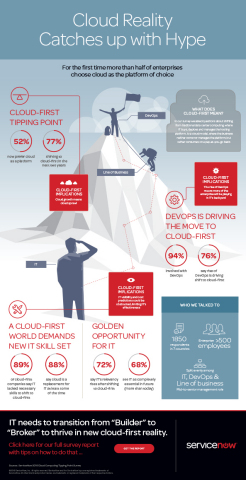SANTA CLARA, Calif.--(BUSINESS WIRE)--ServiceNow (NYSE:NOW), the enterprise cloud company, today released a new report, “The 2016 Cloud Computing Tipping Point.” It reveals adoption reality finally measures up to hype for cloud computing. There are game-changing consequences for IT departments as DevOps’ influence extends across the enterprise.
To better understand the adoption, drivers and implications of an increasingly cloud-centric world, ServiceNow commissioned a survey of 1,850 mid- to senior-level managers. It was a global study, evenly split among IT leaders, line-of-business management and DevOps professionals.
The 2016 Cloud Computing Tipping Point research revealed three significant findings:
Adoption Reality Finally Measures Up to Hype for Cloud Computing
- More than half (52 percent) of respondents said they would choose cloud—software as a service or platform as a service—for new business applications as the platform of choice over on-premises data centers.
- 77 percent said they would complete the shift to cloud within two years.
“For years pundits have waited for an enterprise shift from traditional data center computing to cloud computing,” said Dave Wright, chief strategy officer, ServiceNow. “Today reality meets hype, and cloud-first consumption will accelerate at a break-neck speed in the next two years.”
DevOps Drove the Charge to a Cloud-First World
- Nearly every respondent (94 percent) reported that they are involved in some way with the DevOps movement, a philosophy with origins in the agile development community. The goal of DevOps is to drive the rapid creation and hosting of new apps and services. Traditionally there was little interaction between IT and developers but the DevOps movement aims for early and frequent collaboration between these groups.
- A large majority (76 percent) said that the rise of DevOps is a major factor driving the move to cloud-first. Increasing the development cadence puts pressure on how enterprises deploy new applications. DevOps shines a spotlight on the bottlenecks incurred when hosting apps on company-owned infrastructure. Cloud is the way to rapidly add new streams of revenue-driving apps to fuel business growth.
“Cloud is not new, so why was 2016 the year enterprises became cloud-first? According to the survey, the answer is the rise of DevOps,” said Wright. “DevOps saw early that cloud computing could solve many of the issues they were grappling with. And DevOps’s 'can-do' vibe – enabled by cloud – is extending across the enterprise.”
A Cloud-First World Demands New IT Skill Set
- 89 percent of companies who have completed the shift to a cloud-first model said their current IT staff lacked the required skill sets to be successful in the new cloud world.
- 88 percent feel cloud could be a replacement for a formal IT department at least some of the time.
IT will have to adapt to this new reality, where most of the apps and infrastructure are outside the data center.
- 72 percent said the cloud shift actually raised IT’s relevancy to the business.
- 68 percent said IT will be completely essential in the future.
“Amidst the cloud-first shift, there are ominous signs for IT if there’s no change,” said Wright. “We believe this presents a real opportunity for those visionary IT organizations who can become strategic partners to the enterprise during this shift to cloud-first.”
The cloud-first shift has several likely consequences for IT departments:
-
IT visibility and cost predictions could be obstructed:
According to survey respondents, two top priorities in the cloud shift
were:
- Achieving 360-degree visibility (64 percent)
- Predicting the cost of computing (63 percent)
IT must have full visibility of the organization’s compute environment, including all cloud-based services and applications. Visibility helps IT more effectively manage demand, understand compute costs, utilize cloud- and on-premises-based resources, execute on projects, ensure regulatory compliance, and manage business relationships.
- The rise of DevOps means more of the enterprise will be playing in IT’s backyard: IT teams will be seeing more business app projects coming from the bottom up, and will need to enable the line of business with greater tools to code. At the same time, they’ll need to maintain control of their enterprise environment for security and compliance. They’ll need to delegate development to a growing legion of employees with DevOps skills.
- Cloud growth means cloud sprawl: Implementing more agile cloud management policies and best practices will be critical. Companies will have to deal with a greater number and types of vendors, and those vendors will come and go more quickly than they may be accustomed to. That means Service Integration and Management (SIAM) and vendor management will gain importance.
Read the full survey report to find the five steps to help IT teams transition from a builder to a broker of services.
About the Research
ServiceNow commissioned ReRez Research of Dallas, Texas to survey large organizations in the U.S., U.K., Australia, Singapore, Germany, France and the Netherlands during August 2016. The survey included 1,850 senior managers in total, split evenly between IT, DevOps and line-of-business management roles.
About ServiceNow
ServiceNow is changing the way people work. With a service-orientation toward the activities, tasks and processes that make up day-to-day work life, we help the modern enterprise operate faster and be more scalable than ever before. Customers use our service model to define, structure and automate the flow of work, removing dependencies on email and spreadsheets to transform the delivery and management of services for the enterprise. ServiceNow enables service management for every department in the enterprise including customer service, IT, human resources, facilities, field service and more. We deliver a ‘lights-out, light-speed’ experience through our enterprise cloud – built to manage everything as a service. To find out how, visit www.servicenow.com.
ServiceNow and the ServiceNow logo are registered trademarks of ServiceNow, Inc. All other brand and product names are trademarks or registered trademarks of their respective holders.




